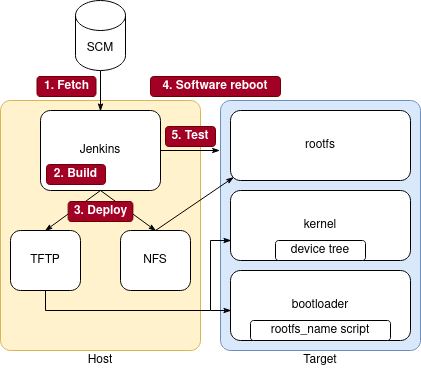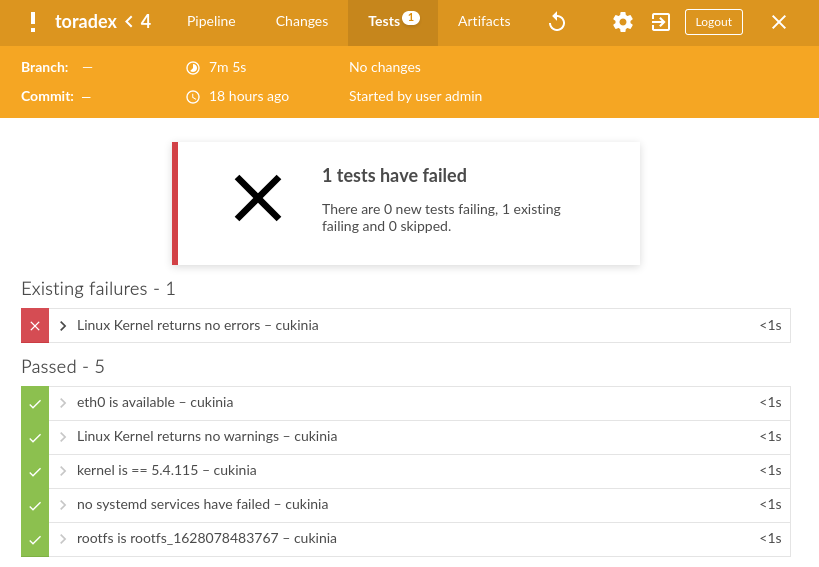Introduction
Continuous Integration (CI) is a development practice that consists in constant and frequent merges of a team’s contributions into a shared repository. Code quality, reliability and non-regression are verified thanks to automated builds and testing prior merging each modification.
Unlike software applications, there are multiple things to consider when setting up a CI with embedded systems:
- Tests cannot be executed on the machine executing the CI because it does not have the same peripherals and CPU architecture. Using virtual machines is possible for systems with a minimal set of hardware interfaces but it will be quickly limited if the hardware is complex or has a lot of connectivity.
- Running the tests should be non-intrusive in order to keep the device-under-test (DUT) as close to the production image as possible. This means that extra environment dependencies should be strictly limited and lightweight testing tools need to be used.
- Tests should not only verify that the application layer is behaving as expected by executing unit tests, but also the operating system itself and even the hardware and firmware functionalities through system-level test suites.
Generally, a CI pipeline for an embedded system includes at least the following stages:
- Fetch code: Like in desktop software, the code must first be obtained. This process can be automatically triggered when a developer creates a new change.
- Build: The entire system image must be recompiled, including the OS and the applications. This step can be extended to check code quality with static analysis tools, and can sometimes be accelerated by leveraging build cache.
- Deploy on target: The newly compiled image needs to be deployed on the target. This step might include flashing the disk, setting a boot from the network, restarting the target…
- Configuration and test: Additional configuration of the environment might be required before running the tests.
- Code integration: Once the code has been successfully tested it can be integrated on another branch, repository, or delivered in another form.

Hardware dependencies and resource constraints make it difficult to find ready-to-use CI solutions for the embedded world. This article presents an open source CI project for embedded systems that is self-hosted and can be easily customized for a wide range of embedded scenarios.
In order to validate the approach, a real case scenario has been deployed based on the i.MX6 Toradex Apalis Evaluation Board.

Additionally, the equivalent pipeline has been developed for a QEMU target machine. It implements the CI chain and runs the same tests but without the need of a physical board.
CI deployment
Jenkins is a widely-used automation server that enables building, testing and deploying the source code on a CI pipeline. It includes installable plugins for handling specific features like SSH connection or the visualization of the pipeline progress and test results.
In order to facilitate reproducibility and configuration, the Jenkins server has been deployed on a Docker container. Source code and instructions on how to use it can be found on https://github.com/savoirfairelinux/base_ci.
Additionally, the Jenkins pipelines used on this Proof of Concept can be found on https://github.com/savoirfairelinux/base_ci_pipeline.
The pipelines can also be used as a template for similar projects.

Build automation
In our example, we used the Yocto project to get a Linux distribution. The Yocto project is an open source collaboration project that helps to produce custom Linux distributions for multiple platforms. It is organized in layers, giving the freedom to easily customize your distribution on top of Yocto base layers and board makers’ layers.
Fetch
The build stage is preceded by the fetch operations. In this stage, the goal is to import sources in the CI environment. During our work, we have used the Toradex sources imported with repo, a tool created to easily fetch sources from multiple git repositories and organize them locally as you want.
We could also easily imagine fetching sources from GitHub, GitLab, Gerrit… Jenkins can as well automatically trigger a job if there are any changes on a remote repository.
Build
Before deploying an image on a target, the CI must ensure that the build succeeds. The build artifacts need to be generated in a clean workspace for reproducibility.
As we were using a Toradex Apalis i.MX6, we wanted to base our work on a generic image provided by Toradex for this board, which does not include extra testing tools. Consequently, we have used the bare manifest provided by Toradex to download the sources with the repo tool.
We have selected the tdx-reference-minimal-image provided from the layer meta-toradex-demos. The only additional installation was python3 in order to be able to use Ansible. It was added in the local configuration of Yocto (CORE_IMAGE_EXTRA_INSTALL += “python3”). To greatly quicken the build, we use a persistent Yocto sstate cache in the Jenkins docker that permits reusing unchanged artifacts across builds.
To ensure build reproducibility, we have used CQFD to set up the build environment. CQFD is a tool developed by Savoir-faire Linux which abstracts Docker complexity and automates it to attach your current working directory into a controlled and reproducible container. The objective is to simplify the usage, the sharing and the update of a build environment across multiple machines and team members. In a CI context, it is an essential feature since the host machine only needs Docker and CQFD installed to be capable of building the software.
Deploy on target
Ensuring that the code compiles is a good first step, but nothing has verified yet that the last modifications did not break the previous features. Therefore, running tests after building is required to assert code quality and detect regressions.
In order to have automatic image deployment just after the build, we have configured the board to boot over the network. A TFTP and an NFS server are needed to import the duo device-tree + kernel and the rootfs respectively. To ease the deployment of these two servers, we decided to create two docker containers launched along with the Jenkins docker server. However, they could also be hosted directly on the machine running the CI, or even on different machines with some tweaks.
On the target side, the bootloader needs to be configured to access the TFTP and NFS servers. Thus, we have configured U-Boot accordingly:
setenv serverip 192.168.X.X
setenv ipaddr 192.168.X.X
Secondly, we need to get the device-tree and the kernel image using TFTP:
tftp ${kernel_addr_r} ${serverip}:zImage
tftp ${fdt_addr_r} ${serverip}:imx6q-apalis-eval.dtb
Then, we need to configure NFS as a source for the rootfs:
setenv bootargs console=${console} root=/dev/nfs rootfstype=nfs ip=dhcp nfsroot=${serverip}:${rootfs_name},v4,tcp
Finally, we can launch the boot by executing:
bootz ${kernel_addr_r} - ${fdt_addr_r}
This configuration can be automatically executed each boot by setting the above commands in the bootcmd variable.
To ensure that only the latest rootfs image that was compiled is run, we added a timestamp to the rootfs directory name. Each boot, the Jenkins pipeline will generate an U-Boot script to edit the environment and point to the correct rootfs. This script will be downloaded by U-Boot in TFTP and sourced to set rootfs_name variable. The unused rootfs directories are later cleaned up.
Once U-Boot is correctly configured, all that is required to boot on the newly deployed image is to reboot the board. In our case this is done by a software reboot command from the Reboot target pipeline stage, but some other setups can include programmable plugs to enable hardware reboots.
For the first build with Jenkins, the board will probably not boot if you already have correctly configured U-Boot because no rootfs was available. A hardware reboot will be required at the end of the first build, as a software reboot will not be possible.

Remote management and tests
Once the newly generated images have been booted on the target device, the CI can start running the tests. This step requires minimal intrusive interaction with the target machine. Ansible is a tool that offers the automation of remote tasks over an SSH connection and Python3 on the target machine. Please note that other tools, like the standalone SSH protocol itself, could be used as an alternative to Ansible for this purpose.
Ansible organises its tasks in playbooks that can be remotely executed according to an inventory of machines (add link to our base_ci/ansible on GitHub/GitLab). In our pipeline, Ansible handles the reboot of the target machine from the previous image. It also sends and runs the tests on the target, and finally fetches the result to generate a report
A mechanism for remote and non-intrusive verification has to be used, usually testing both high and low level functionalities. We decided to use Cukinia. Cukinia is a shell-based testing tool developed by Savoir-faire Linux. It is designed to run simple system-level validation tests for Linux-based embedded firmwares. Cukinia is integrated in the Yocto base layer meta-oe.
Once the test results are fetched, a JUnit report is displayed by the CI.

Code Integration
Having the result of the tests for each build can lead to two scenarios. In the case where there are failed tests, the developer should be capable of easily identifying the cause of the broken scenario and fixing it. On the other hand, once the CI passes the tests successfully, the code can be considered ready for integration. Normally, this stage might represent merging the code on a “release” branch, pushing it to a different repository or launching a more complex delivery process.
Conclusion
Having a CI in embedded system software development is a huge help to detect issues and resolve them as early as possible. Adding a test on target step in this CI takes part in increasing the quality of the released code.
This article proves that there is a simple way to deploy and run tests quickly and automatically on an embedded device. The example that we are providing, is of course customizable by creating your own pipeline for your context.












